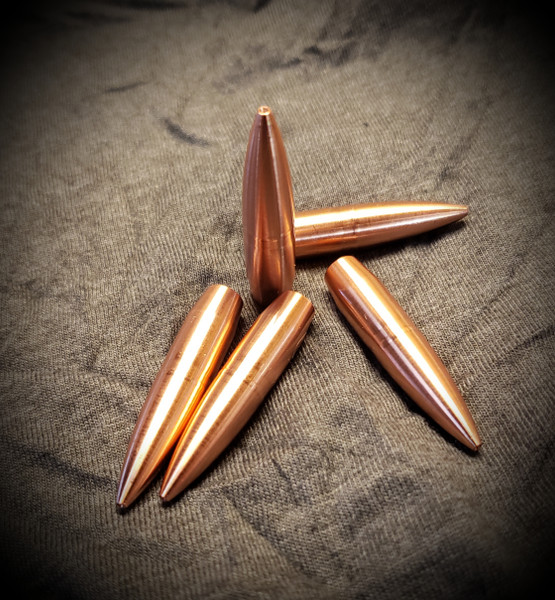...or what can the .308 do to keep pace with the 6.5 creedmoor ad nausea
If I may make an open ended suggestion.
There has been a very long winded debate about the various 6.5 caliber offerings vs the .308/7.62 NATO/30 Cal as of late.
Some of the more ridiculous comments have included the fact (yes, fact) that the 6.5 Creedmoor retains enough velocity at extreme range to still be supersonic to nearly 1,400 yards while the .308 is passing through the transonic barrier somewhere between 900 and 1,000 yards.
Add to this the complaint that the 6.5 terminal ballistics are abysmal with all but what I would call boutique projectiles and ineffective on larger game such as elk.This was stated without any discussion about range of engagement .
Now lump this all into one post. I wish I could find that rant again but I have such a convoluted and lengthy browsing history across many machines that I , squirrel ! ………………..
FFS
I do not know of any projectile capable of even moderate performance over a span of nearly 2,000 feet per second. On the high side they blow up on contact and on the low side they pass through without expansion. It’s physics FFS.
Part of the equation is the reduced cross sectional area of the 6.5 plus its greater length to diameter ratio for the same given weight. Sectional density is easily confused with the length to diameter ratio as the former is more closely related to terminal ballistics and the later more closely associated with external ballistics.
Since this is the comparison between the two calibers it would seem that for the .308 to keep pace with the 6.5 it would need to be longer. This becomes a mass equation. The length can’t be added without making the bullet heavier. The answer is to eliminate the lead and create a bullet that is longer by the addition of copper to it’s length to replace the mass of the lead. Seems easy now doesn’t it? Not so fast. First there is barrel wear which is actually a fairly simple problem in metallurgy. Guilding and or bearing metal alloys are well known in industry and this seems to be the only straight forward part of the thought. Next is stability of the bullet which is also fairly well understood. Note here that most BTHP (actually open tip rather than hollow point) target bullets are mostly void (air) behind the ogive with most of the mass at the base. So now we’re at a longer bullet with more sectional density and a better ballistic coefficient because of it’s length. So far so good. Now on to terminal ballistics. Prior to closing the tip of the bullet score the inside of the forward cavity. This will of course take large sample size of experimentation. Then anneal the forward section of the bullet to make it malleable and promote expansion without disintegration at higher velocities while predictably expanding at lower velocities.
What to do with the extra length of the bullet? At some point you run out of magazine length and are single loading. This is fine for the paper puncher but not so much for the hunter or other shooter. So the bullet gets seated deeper in the case. In my case it’s fortunate that I kept all my reloading and range information for decades past. I had more than a few loads that were not full capacity with 147gr or 168gr for that matter that were bypassed possibly because they did not fill the case leading to inconsistent pressures and velocity. Now not all of these loads will show promise either because of powder availability or pressures or other variables but I’m sure there is a gem or three in there somewhere.
In the end it’s a worthy thought experiment at the very least. It’s environmentally friendly by eliminating the lead. The bullets can be made with not much more than a lathe and an arbor press from 5/16″ and 3/8″ copper bar stock with minimal waste. Those in the manufacturing industry can see the possibilities of coining, drawing, trimming, reaming, scoring, forming, sizing and annealing, all on a modified punch press and draw line.
All this to keep up with the latest caliber of the month club.On the surface it seems a bit silly to gain another few hundred yards of supersonic velocity out of the .308. However the capability of making your own high performance projectiles has some appeal. Getting rid of the lead is not only environmentally sound but it’s also one less raw material to source.
This is only somewhat more than a thought experiment at this point. I will gladly accept any and all suggestions.
YMMV
Kudos if you read it.
If I may make an open ended suggestion.
There has been a very long winded debate about the various 6.5 caliber offerings vs the .308/7.62 NATO/30 Cal as of late.
Some of the more ridiculous comments have included the fact (yes, fact) that the 6.5 Creedmoor retains enough velocity at extreme range to still be supersonic to nearly 1,400 yards while the .308 is passing through the transonic barrier somewhere between 900 and 1,000 yards.
Add to this the complaint that the 6.5 terminal ballistics are abysmal with all but what I would call boutique projectiles and ineffective on larger game such as elk.This was stated without any discussion about range of engagement .
Now lump this all into one post. I wish I could find that rant again but I have such a convoluted and lengthy browsing history across many machines that I , squirrel ! ………………..
FFS
I do not know of any projectile capable of even moderate performance over a span of nearly 2,000 feet per second. On the high side they blow up on contact and on the low side they pass through without expansion. It’s physics FFS.
Part of the equation is the reduced cross sectional area of the 6.5 plus its greater length to diameter ratio for the same given weight. Sectional density is easily confused with the length to diameter ratio as the former is more closely related to terminal ballistics and the later more closely associated with external ballistics.
Since this is the comparison between the two calibers it would seem that for the .308 to keep pace with the 6.5 it would need to be longer. This becomes a mass equation. The length can’t be added without making the bullet heavier. The answer is to eliminate the lead and create a bullet that is longer by the addition of copper to it’s length to replace the mass of the lead. Seems easy now doesn’t it? Not so fast. First there is barrel wear which is actually a fairly simple problem in metallurgy. Guilding and or bearing metal alloys are well known in industry and this seems to be the only straight forward part of the thought. Next is stability of the bullet which is also fairly well understood. Note here that most BTHP (actually open tip rather than hollow point) target bullets are mostly void (air) behind the ogive with most of the mass at the base. So now we’re at a longer bullet with more sectional density and a better ballistic coefficient because of it’s length. So far so good. Now on to terminal ballistics. Prior to closing the tip of the bullet score the inside of the forward cavity. This will of course take large sample size of experimentation. Then anneal the forward section of the bullet to make it malleable and promote expansion without disintegration at higher velocities while predictably expanding at lower velocities.
What to do with the extra length of the bullet? At some point you run out of magazine length and are single loading. This is fine for the paper puncher but not so much for the hunter or other shooter. So the bullet gets seated deeper in the case. In my case it’s fortunate that I kept all my reloading and range information for decades past. I had more than a few loads that were not full capacity with 147gr or 168gr for that matter that were bypassed possibly because they did not fill the case leading to inconsistent pressures and velocity. Now not all of these loads will show promise either because of powder availability or pressures or other variables but I’m sure there is a gem or three in there somewhere.
In the end it’s a worthy thought experiment at the very least. It’s environmentally friendly by eliminating the lead. The bullets can be made with not much more than a lathe and an arbor press from 5/16″ and 3/8″ copper bar stock with minimal waste. Those in the manufacturing industry can see the possibilities of coining, drawing, trimming, reaming, scoring, forming, sizing and annealing, all on a modified punch press and draw line.
All this to keep up with the latest caliber of the month club.On the surface it seems a bit silly to gain another few hundred yards of supersonic velocity out of the .308. However the capability of making your own high performance projectiles has some appeal. Getting rid of the lead is not only environmentally sound but it’s also one less raw material to source.
This is only somewhat more than a thought experiment at this point. I will gladly accept any and all suggestions.
YMMV
Kudos if you read it.



